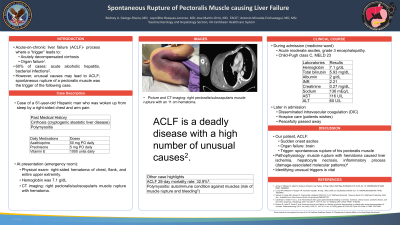Sunday Poster Session
Category: Liver
P1394 - Spontaneous Rupture of Pectoralis Muscle Causing Liver Failure
Sunday, October 27, 2024
3:30 PM - 7:00 PM ET
Location: Exhibit Hall E

Has Audio
- RG
Rodney A. George-Rivera, MD
VA Caribbean Healthcare System
San Juan, PR
Presenting Author(s)
Rodney A. George-Rivera, MD, Jaymilitte Bosques-Lorenzo, MD, Jose Martin-Ortiz, MD, FACG, Antonio Miranda-Enchautegui, MD
VA Caribbean Healthcare System, San Juan, Puerto Rico
Introduction: Acute-on-chronic liver failure (ACLF) is a process where an inflammatory event leads to decompensation of cirrhosis and extrahepatic organ failure. Approximately 60% of the events leading to ACLF are identified by physicians; alcoholic hepatitis and sepsis account for most of the cases. However, unusual events may lead to ACLF; spontaneous rupture of a pectoralis muscle was the culprit of the following case.
Case Description/Methods: Case of a 61-year-old Hispanic man who presented to the ED due to a right-sided chest and arm pain that woke him up from sleep. Past medical history included cirrhosis secondary to cryptogenic steatotic liver disease and polymyositis. Daily medications included azathioprine 50 mg, prednisone 5 mg, and vitamin E 1000 units. At the ED, the physical exam showed a right-sided hematoma involving the chest and entire upper extremity. Acknowledging that polymyositis is an autoimmune condition against muscles, predisposing them to rupture and bleed, the emergency physician ordered bloodwork and imaging. Results included anemia (Hgb 7.1 g/dL.), right-sided pectoralis/subscapularis muscle rupture, and an 11 cm hematoma. The patient was admitted to the medical ward, where he developed acute moderate ascites and grade 1 encephalopathy. At the time, he had a Child-Pugh class C and MELD score of 23 due to hyperbilirubinemia (5.93 mg/dL), hypoalbuminemia (2 g/dL), a high INR (2.21), low creatinine levels (0.27 mg/dL), and normal sodium levels (136 mEq/L); also seen where mild elevations of AST and ALT (116 U/L and 60 U/L, respectively.) Despite aggressive management, the patient’s hematoma recurred, leading to the suspicion and eventual diagnosis of disseminated intravascular coagulation (DIC.) He decided to receive comfort care only; later, he was admitted to hospice.
Discussion: In our patient, ACLF was evidenced by the sudden onset of ascites, encephalopathy, and DIC following the spontaneous rupture of his pectoralis muscle. Muscle rupture leads to ACLF via liver ischemia, hepatocyte necrosis, and an inflammatory process mediated by damage-associated molecular patterns. Consequently, the 28-day mortality rate of ACLF is 32.8%; thus, identifying unusual triggers is vital when facing the disease.

Disclosures:
Rodney A. George-Rivera, MD, Jaymilitte Bosques-Lorenzo, MD, Jose Martin-Ortiz, MD, FACG, Antonio Miranda-Enchautegui, MD. P1394 - Spontaneous Rupture of Pectoralis Muscle Causing Liver Failure, ACG 2024 Annual Scientific Meeting Abstracts. Philadelphia, PA: American College of Gastroenterology.
VA Caribbean Healthcare System, San Juan, Puerto Rico
Introduction: Acute-on-chronic liver failure (ACLF) is a process where an inflammatory event leads to decompensation of cirrhosis and extrahepatic organ failure. Approximately 60% of the events leading to ACLF are identified by physicians; alcoholic hepatitis and sepsis account for most of the cases. However, unusual events may lead to ACLF; spontaneous rupture of a pectoralis muscle was the culprit of the following case.
Case Description/Methods: Case of a 61-year-old Hispanic man who presented to the ED due to a right-sided chest and arm pain that woke him up from sleep. Past medical history included cirrhosis secondary to cryptogenic steatotic liver disease and polymyositis. Daily medications included azathioprine 50 mg, prednisone 5 mg, and vitamin E 1000 units. At the ED, the physical exam showed a right-sided hematoma involving the chest and entire upper extremity. Acknowledging that polymyositis is an autoimmune condition against muscles, predisposing them to rupture and bleed, the emergency physician ordered bloodwork and imaging. Results included anemia (Hgb 7.1 g/dL.), right-sided pectoralis/subscapularis muscle rupture, and an 11 cm hematoma. The patient was admitted to the medical ward, where he developed acute moderate ascites and grade 1 encephalopathy. At the time, he had a Child-Pugh class C and MELD score of 23 due to hyperbilirubinemia (5.93 mg/dL), hypoalbuminemia (2 g/dL), a high INR (2.21), low creatinine levels (0.27 mg/dL), and normal sodium levels (136 mEq/L); also seen where mild elevations of AST and ALT (116 U/L and 60 U/L, respectively.) Despite aggressive management, the patient’s hematoma recurred, leading to the suspicion and eventual diagnosis of disseminated intravascular coagulation (DIC.) He decided to receive comfort care only; later, he was admitted to hospice.
Discussion: In our patient, ACLF was evidenced by the sudden onset of ascites, encephalopathy, and DIC following the spontaneous rupture of his pectoralis muscle. Muscle rupture leads to ACLF via liver ischemia, hepatocyte necrosis, and an inflammatory process mediated by damage-associated molecular patterns. Consequently, the 28-day mortality rate of ACLF is 32.8%; thus, identifying unusual triggers is vital when facing the disease.

Figure: On the left side of the image is our patient’s large hematoma. On the right side of the image, hematoma is seen on CT imaging.
Disclosures:
Rodney A. George-Rivera indicated no relevant financial relationships.
Jaymilitte Bosques-Lorenzo indicated no relevant financial relationships.
Jose Martin-Ortiz indicated no relevant financial relationships.
Antonio Miranda-Enchautegui indicated no relevant financial relationships.
Rodney A. George-Rivera, MD, Jaymilitte Bosques-Lorenzo, MD, Jose Martin-Ortiz, MD, FACG, Antonio Miranda-Enchautegui, MD. P1394 - Spontaneous Rupture of Pectoralis Muscle Causing Liver Failure, ACG 2024 Annual Scientific Meeting Abstracts. Philadelphia, PA: American College of Gastroenterology.

